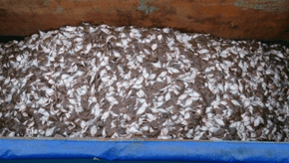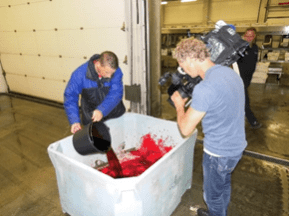Evaluation of Council Regulation (EC) No 1100/2007 of 18 September 2007 establishing measures for the recovery of the stock of European eel.
“We strongly support the upcoming evaluation and welcome this opportunity to provide feedback on the effectiveness and implementation of the EU Eel Regulation.”
The population of European eel has declined dramatically since the 1970s*. Recruitment of juvenile eels remains extremely low despite the joint EU management framework, which has now been in place for 10 years. The state of European eel remains critical and further action is urgently needed.
Earlier evaluations indicate that the current EU management framework is insufficient and show that implementation of the regulation and of the national eel management plans has been delayed, piecemeal and focused on efforts with little discernible impact on the recovery of the European eel population. Notably, it has been very difficult to measure progress against the main target – at least 40% escapement of silver eels. While a strong focus of resources has been placed on restocking of eel, there is no evidence that this effectively contributes to future recruitment. Most countries maintain a directed fishery, and illegal catches and trafficking of glass eels remain a major problem.
Habitat loss and deteriorating water quality also affect eel. The latest assessment of the implementation of the Water Framework Directive shows poor status for around 60% of surface water bodies and a massive presence of migration barriers**.
Since the Eel Regulation came into force, some major changes in related EU policies have taken place. Notably, the reform of the Common Fisheries Policy resulted in the new commitment to restoring the biomass of all harvested fish stocks above levels capable of producing Maximum Sustainable Yield (MSY). MSY is also used as a key criterion to assess Good Environmental Status under the Marine Strategy Framework Directive. We are therefore particularly pleased to see the evaluation’s focus on coherence with other EU legislation, as well as with international instruments.
We ask the European Commission to ensure that this evaluation of the effectiveness and coherence of the measures taken to aid the recovery of European eel assesses all aspects of eel management and potential options for the future, including:
- The objective of 40% escapement of silver eels and whether it is in coherence with the precautionary principle and the MSY objective
- The effectiveness of fisheries closures/restrictions for all life stages
- The targets and indicators set in the national eel management plans, as well as the national monitoring to measure progress
- Reporting and data collection obligations
- Restocking practices and the associated overall effectiveness in terms of conservation
- Progress on measures to address other major anthropogenic impacts on eel, primarily habitat restoration and removal of migration barriers
- The use of public funds (EMFF) and whether it has aided eel recovery
- The substantial illegal trade of European eel outside of and inside the EU and its effect on eel conservation
- Control and enforcement issues related to the entire chain, from glass eel fisheries to consumption of eel products, including more coordinated action between the Member States’ enforcement agencies
- The implementation of EU commitments within the framework of CMS and CITES
Bearing all of the above in mind, we look forward to a thorough evaluation of all aspects of the European eel management framework, and to future opportunities to engage with this process.
It is our hope that through implementation of urgent measures and better management and protection in the future, we can enable long-term recovery and sustainable exploitation of European eel, but we note that we are a very long way from there today.
Submitted by: ClientEarth, European Anglers Alliance, FishSec, Good Fish Foundation, Our Fish, Pew Charitable Trusts, Seas At Risk and WWF
Download as PDF: Eel Evaluation Roadmap NGO submission
*www.ices.dk/sites/pub/Publication%20Reports/Advice/2017/2017/ele.2737.nea.pdf
**www.eea.europa.eu/themes/water/status-and-monitoring/state-of-surface-waters
Background: EU begins evaluation of eel management
On 13 April 2018, the European Commission released a Roadmap for the upcoming evaluation of the Eel Regulation. The evaluation is set to help the Commission decide whether to review the regulation or focus on improving implementation. Stakeholders are invited to provide feedback on issues related to the implementation of the Eel Regulation until 11 May 2018, and then in a second consultation in October.
The so called Evaluation and Fitness Check Roadmap of Council Regulation (EC) No 1100/2007 of 18 September 2007 establishing measures for the recovery of the stock of European eel provides background on the issue and explains the process and focus for the evaluation. The intention is to inform stakeholders and enable them to participate effectively in the process as well as provide views and possible solutions for better eel management. It is the first step of a process that may take several years.
The evaluation process started in Spring 2018, with a final report expected in the first quarter of 2019. It consists of three parts: an external evaluation of the management framework, an ICES assessment of the biological aspects and a Commission review of the use of public funds to support implementation. The first public feedback period (open 13 April to 11 May) is intended to inform the initial phase of the evaluation, whereas the second public consultation in October will give stakeholders a chance to reflect on some of the initial results and provide views on potential measures.
First evaluation found significant delays
This will be the second EU evaluation since the Eel Regulation came into force in September 2007. The previous evaluation took place after the first national progress reports were submitted in 2012 and a report was presented to the Council and European Parliament in 2014 (in line with requirements in the regulation (Art. 9.2)).
The first evaluation found that the status of the European eel remained critical and in need of urgent action and that the implementation of the Eel Regulation had suffered significant delays. It also found that most of the management measures taken were related to fisheries, whereas other measures such as improving habitats or controlling predators and parasites had been postponed or only partially implemented. Altogether, it was difficult to assess progress towards the main objective of increasing silver eel escapement due to all the delays and the long timeframes involved. It also highlighted that few countries had reached their restocking targets and there was concern that restocking practices may not contribute to increased escapement but instead sustained the fishing for eel.
This second evaluation is therefore crucial in terms of assessing the effects of management measures, as more time has passed. Also, since the previous Commission report, the reformed CFP (Regulation (EU) 1380/2013) objective of Maximum Sustainable Yield (MSY) has been applied to stock management.
Effectiveness and coherence in focus
The emphasis of this evaluation is on the effectiveness and coherence of the measures taken to aid the recovery of European eel, in particular through the national Eel Management Plans. A number of areas are listed, including the design and implementation of restocking efforts, the management of glass eel fisheries, enforcement and monitoring both in marine and inland waters, coherence with other EU legislation and international instruments, including CITES and CMS, as well as the use of public money from the European Maritime and Fisheries Fund (EMFF) to aid implementation.
The Commission is now awaiting Member State reports on the use of EMFF funds, implementation of the Water Framework Directive and, in particular, the national eel management plans in order to gather the information needed for the external and internal evaluations. ICES has put out an extended data call on eel to support its work.
When the evaluation report is finalised in early 2019, the Commission will make its decision on the way forward, probably including an Impact Assessment of potential measures. If the regulation needs to be revised, this is a longer process with proposals for amendments that will need to be discussed and agreed between the Council and the European Parliament. It could take years, particularly considering that 2019 is the year of European Parliament elections, the appointment of a new European Commission and Brexit.
Meanwhile, European eel remains listed as Critically Endangered by IUCN, trade is restricted under CITES Annex II and efforts are ongoing to support its conservation under the Convention on the conservation of Migratory Species of Wild Animals (CMS). European eel is still in need of urgent actions to support its recovery.
A Commission attempt last year to close all EU fishing of adult eels – arguably the most rapid way to aid increased reproduction – was not supported by the Member States. Instead, a joint Declaration on strengthening the recovery for European eel was agreed, committing Member States to step up their actions, including a review of current restocking practices and fighting illegal fishing and trade. In the context of fishing opportunities for 2018, a 3-month ban on fishing for European eel of 12 cm or more is to be implemented by the Member States between 1 September 2018 and 31 January 2019. .
Across the wide geographical spread of European eel, responses to its plight have been slow, patchy and largely ineffective. The first reports of substantial decline came already in the 1970s, but it took over three decades to get agreement on a management framework for the European Union and a listing under CITES Annex II to restrict trade.
The European eel regulation (EC 1100/2007) was finally adopted in 2007. It is a framework regulation with an overarching objective (Art. 2.4) – 40 % escapement of silver eel biomass compared to pre-anthropogenic levels – and an agreed set of measures to use. It requires Member States to create and implement Eel Management Plans for each “eel river basin”, and to submit progress reports every third year, beginning in June 2012.
The implementation of the eel management plans has been riddled with problems, including delays, a lack of reporting, a misuse of measures to support fishing rather than conservation and a very substantial illegal trade in glass eels with countries outside of the EU. Against this background, the upcoming evaluation is incredibly important.
Photo: Actress Florence Keith-Roach “98.4% of the European eel population is already GONE. Continuing to fish for them is like hunting pandas!”
Photo credit: @Fishlove/Jillian Edelstein, fishlove.co.uk. Check out this story on the collaboration between Our Fish and Fish Love.


 While fishermen are used to discarding too young (undersized) bycatch, they now have to land them and largely destroy them. Fishermen emphasize in their protests that they do so against their will. Their protest is strongly emphasized with dramatic photographs, showing how young fish unfit for consumption are destroyed using red dye, cleverly framing the the landing obligation as a unworkable set of rules from Brussels.
While fishermen are used to discarding too young (undersized) bycatch, they now have to land them and largely destroy them. Fishermen emphasize in their protests that they do so against their will. Their protest is strongly emphasized with dramatic photographs, showing how young fish unfit for consumption are destroyed using red dye, cleverly framing the the landing obligation as a unworkable set of rules from Brussels. With slogans like ‘give baby fish a chance’, the fishermen actually protest against their own current practices.
With slogans like ‘give baby fish a chance’, the fishermen actually protest against their own current practices. 
 Regelgedrocht Terwijl vissers voorheen te jonge (ondermaatse) bijvangst overboord kieperden, moeten ze die nu aan land brengen en grotendeels vernietigen. Vissers benadrukken in hun protesten dat ze dat tegen hun zin doen. Hun protest wordt dik aangezet met dramatische foto’s waarop jonge vis met behulp van rode verf ongeschikt wordt gemaakt voor consumptie. Zo wordt de aanlandplicht slim geframed als het zoveelste regelgedrocht uit Brussel. Maar meer levend rondzwemmende jonge vis in zee betekent op lange termijn ook meer vis voor de visser. Deze wet zal er voor zorgen dat de jonge vis in zee blijft leven. Hij gaat vissers stimuleren om duurzamer en selectiever te vissen. Dat is hard nodig, want in de tientallen jaren voor de nieuwe wet liep de verspilling van bijvangst de spuigaten uit. In 2011 werd in Europa 1,7 miljoen ton vis meer dood dan levend weer overboord gegooid, wat neer komt op 23 procent van alle vangst. In de Nederlandse visserij was dat 57 miljoen kilo bijvangst, waarvan het leeuwendeel (47 miljoen) door onder meer de protesterende kottervissers. Juist om aan deze destructieve praktijk een einde te maken kwam de EU, onder publieke druk, met de aanlandplicht.
Regelgedrocht Terwijl vissers voorheen te jonge (ondermaatse) bijvangst overboord kieperden, moeten ze die nu aan land brengen en grotendeels vernietigen. Vissers benadrukken in hun protesten dat ze dat tegen hun zin doen. Hun protest wordt dik aangezet met dramatische foto’s waarop jonge vis met behulp van rode verf ongeschikt wordt gemaakt voor consumptie. Zo wordt de aanlandplicht slim geframed als het zoveelste regelgedrocht uit Brussel. Maar meer levend rondzwemmende jonge vis in zee betekent op lange termijn ook meer vis voor de visser. Deze wet zal er voor zorgen dat de jonge vis in zee blijft leven. Hij gaat vissers stimuleren om duurzamer en selectiever te vissen. Dat is hard nodig, want in de tientallen jaren voor de nieuwe wet liep de verspilling van bijvangst de spuigaten uit. In 2011 werd in Europa 1,7 miljoen ton vis meer dood dan levend weer overboord gegooid, wat neer komt op 23 procent van alle vangst. In de Nederlandse visserij was dat 57 miljoen kilo bijvangst, waarvan het leeuwendeel (47 miljoen) door onder meer de protesterende kottervissers. Juist om aan deze destructieve praktijk een einde te maken kwam de EU, onder publieke druk, met de aanlandplicht. 



